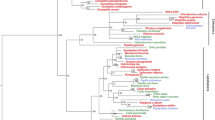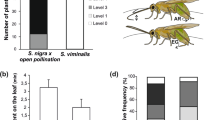Abstract
Though acridids are generally polyphagous, they are not indiscriminate feeders as is observed, on the basis of extensive studies on several species of grasshoppers likeEyprepocnemis alacris alacris (Serv.),Oxya nitidula (Walker), etc. The feeding behaviour of such herbivorous insects in general is of immense importance because of their direct relevance to applied ecological problems. These insects live in environments with abundance of food, but their suitability is differently related to each available plant species in the environment. Hence the feeding behaviour patterns are seen to be generally influenced by several factors such as the morphological correlates of the insect as well as the physico-chemical factors of the host plant.
In this context, consideration is being given to, (a) physical factors of the host plant such as the thickness of the leaf lamina, the presence of trichomes, the position of the leaf blade, the general colour pattern and the effect of blinding, (b) morphological correlates of the insect such as mandibular modifications in relation to the host, its changes during post-embryonic development and their role in the shift of the host, the foregut armature and its influence on host selection, (c) the influence of chemicals like silica, phagostimulants and deterrents of the hosts on the insect feeding behaviour and (d) the role of sensory structures of the insect in the detection and discrimination of the host.
In addition to the discussion on the general pattern of feeding, the factors responsible for the initiation, continuation and termination of feeding are also analysed.
Similar content being viewed by others
References
Abushama F T 1968 Food selection byPoikilocerus hieroglyphicus (Klug.) (Acrididae: Pyrgomorphinae) and some of the receptors involved;Proc. R. Entomol. Soc. London 43 96–104
Adams C M and Bernays E A 1978 The effect of combinations of deterrents on the feeding behaviour ofLocusta migratoria (L);Entomol. Exp. Appl. 23 101–109
Azzi AE A 1975A study of some factors affecting food consumption by the desert locust, Schistocerca gregaria (Forsk.); Ph.D. Thesis, University Wales, Bangor
Ba-Angood S A S 1977 Observations on food preference and feeding habits of three important species of Acrididae in Sudan;Z. Angew. Entomol. 83 344–350
Barton Browne L 1975 Regulatory mechanisms in insect feeding;Adv. Insect Physiol. 11 1–116
Barton Browne L, Moorhouse J E and van Gerwen A C M 1975 Sensory adaptation and the regulation of meal size in the Australian plague locust,Chortoicetus terminifera;J. Insect Physiol. 21 1633–1639
Bernays E A 1978 Tannins: an alternative view point;Entomol. Exp. Appl. 24 244–253
Bernays E A 1980 The post-prandial rest inLocusta migratoria nymphs and its hormonal regulation;J. Insect Physiol. 26 119–123
Bernays E A and Chapman R F 1970 Experiments to determine the basis of food selection byChorthippus parallelus (Zett.) (Orthoptera: Acrididae) in the field;J. Anim. Ecol. 39 383–394
Bernays E A and Chapman R F 1972 Meal size in nymphs ofLocusta migratoria;Entomol. Exp. Appl. 15 399–410
Bernays E A and Chapman R F 1973 The regulation of feeding inLocusta migratoria; internal inhibitory mechanisms;Entomol. Exp. Appl. 16 329–342
Bernays E A and Chapman R F 1974 The regulation of food intake by acridids InExperimental analysis of insect behaviour (ed.) L Barton Browne (Berlin, Heidelberg, New York: Springer-Verlag) 48–59
Bernays E A and Chapman R F 1977 Deterrent chemicals as a basis of oligophagy inLocusta migratoria (L);Ecol. Entomol. 2 1–18
Bernays E A and Chapman R F 1978 Plant chemistry and acridid feeding behaviour InBiochemical aspects of plant and animal co-evolution (ed.) J B Harborne (London: Academic Press) 99–141
Bernays E A, Blaney W M and Chapman R F 1972 Changes in the chemoreceptor sensilla on the maxillary palps ofLocusta migratoria in relation to feeding;J. Exp. Biol. 57 745–753
Bernays E A and Mordue A J 1973 Control of changes in palp tip sensilla: the effect of different levels of hormone from the corpus cardiacum;Comp. Biochem. Physiol. 45 451–454
Blaney W M 1974 Electrophysiological responses of the terminal sensilla on the maxillary palps ofLocusta migratoria (L) to some electrolytes and non-electrolytes;J. Exp. Biol. 60 275–293
Blaney W M and Chapman R F 1969a The anatomy and histology of the maxillary palp ofSchistocerca gregaria (Orthoptera: Acrididae)J. Zool. London 157 509–535
Blaney W M and Chapman R F 1969b The fine structure of the terminal sensilla on the maxillary palps ofSchistocerca gregaria (Forsk) (Orthoptera: Acrididae);Z. Zellforsch Mikrosk Anal. 99 74–97
Blaney W M and Chapman R F 1970 The functions of the maxillary palps of Acrididae (Orthoptera);Ent. Exp. Appl. 13 363–376
Blaney W M, Chapman R F and Cook AG 1971 The structure of the terminal sensilla of the maxillary palps ofLocusta migratoria (L) and changes associated with moulting;Z. Zellforsch Mikrosk Anat. 121 48–68
Blaney W M and Duckett A M 1975 The significance of palpation by the maxillary palps ofLocusta migratoria (L): an electrophysiological and behavioural study;J. Exp. Biol. 63 701–712
Blaney W M, Chapman R F and Wilson A 1973 The pattern of feeding inLocusta migratoria (Orthoptera: Acrididae);Acrida 2 119–137
Cazal M 1969 Actions d’extraits de corpora cardiaca sur le peristaltisme intestinal deLocusta migratoria;Arch. Zool. Exp. Gen. 110 83–90
Chapman RF 1954 Some light responses ofLocusta migratoria migratorioides (R&F) in the laboratory;Br. J. Anim. Behav. 2 146–152
Chapman R F 1955 Roosting behaviour in some African grasshoppers. Entomologist’s mon. Mag91 76–81
Chapman R F 1974a The chemical inhibition of feeding by phytophagous insects: a review;Bull. Entomol. Res. 64 339–363
Chapman R F 1974bFeeding in leaf eating insects (London: Oxford Univ. Press) pp. 16
Chapman R F 1977 The role of leaf surface in food selection by acridids and other insects;Coll. Int. C.N.R.S. No 265 133–149
Chapman R F 1978 The number and distribution of sensilla on the mouth parts of Acridoidea;Acrida 7 115–148
Chapman R F 1982 (ed.) Regulation of food intake by phytophagous insects InExogenous and endogenous influences on metabolic and neural control (Pergamon Press: Addink and Spronk) 19–30
Chapman R F and Thomas J G 1978 The numbers and distribution of sensilla on the mouth parts of Acridoidea;Acrida 7 115–148
Cook A G 1972 The ultra-structure of the Al sensilla on the posterior surface of the clypeo-labrum ofLocusta migratoria migratorioides (R & F);Z. Zellforsch. 134 539–554
Cook A G 1976 A critical review of the methodology and interpretation of experiments designed to assay the phagostimulatory activity of chemicals to phytophagous insects;Symp. Biol. Hung. 16 47–54
Cook A G 1977 Nutrient chemicals as phagostimulants forLocusta migratoria (L);Ecol. Entomol. 2 113–121
Cook A G 1979 The ultra-structure of some sensilla on the clypeo-labrum ofLocusta migratoria (L);Acrida 8 47–62
Cresitelli F and Jahn T 1939 The electrical responses of the dark adapted grasshopper eye to various intensities of illumination and to different qualities of light;J. Cell. Comp. Physiol. 19 105–112
Dethier V G 1966 Feeding behaviour;Proc. III Symp. R. Entomol. Soc. London 46–58
Frings H and Frings M 1949 The loci of contact chemoreceptors in insects;Am. Midl. Nat. 41 603–658
Gangwere S K 1966 Relationship between the mandibles, feeding behaviour and damage inflicted on plants by the feeding of certain acridids;Michigan Entomol. 1 13–16
Gangwere S K 1972 Host finding and feeding behaviour on the Orthopteroidea especially as modified by food availability; a review;Rev. Univ. Madr. 21 107–158
Goodhue D 1963 Feeding stimulants required by a polyphagous insect,Schistocerca gregaria;Nature (London) 197 405–406
Hjelle D K and Mulkern G B 1964 National foundation research participation for high school teachers programme. GE 3097 and 7639
Haskell P T and Schoonhoven L M 1969 The function of certain mouth part receptors in relation to feeding inSchistocerca gregaria andLocusta migratoria migratoria;Entomol. Exp. Appl. 12 423–440
Kaufmann T 1965 Observations on aggregation, migration and feeding habits ofZonocerus variegatus in Ghana (Orthoptera: Acrididae);Ann. Entomol. Soc. Am. 58 426–436
Kaufmann T 1968 A laboratory method of feeding habits ofMelanoplus differentialis in Maryland (Orthoptera: Acrididae);Ann. Entomol. Soc. Am. 61 173–180
Kendall 1971Studies on the tarsi of Schistocerca gregaria Forsk. Ph.D. Thesis, University of London
Le Berre J R, Sinoir Y and Boulay C 1967 Elude de l’equipement sensoriel de l’article distal des palps chez la larve deLocusta migratoria migratorioides (R et F);C.R. Acad. Sci. (Paris) D265 1717–1720
Louveaux A 1973 Etude d’une plage d’organes sensoriels sur les galea deLocusta migratoria (L);C.R. Acad. Sci. (Paris) 277 1353–56
Meera M 1982Studies on the bio-ecology of Oxya nitidula (Walker) Ph.D. Thesis, Madras University, India
Mehrotra K N and Rao P J 1966 Phagostimulants for locusts;Indian J. Exp. Biol. 4 56–57
Mulkern G B and Mongolkiti S 1977 Grasshopper feeding behaviour and development of edible carriers for grasshopper control agents;Rev. Soc. Entomol. Argentina 36 59–84
Mulkern G B, Records J C and Carlson R B 1978 Attractants and phagostimulants used for control and estimation of grasshopper populations;Entomol. Exp. Appl. 24 550–561
Muralirangan M C and Ananthakrishnan T N 1974 Taxonomic significance of the foregut armature in some south Indian Acridoidea (Orthoptera);Orient. Insects 8 119–145
Muralirangan M C and Ananthakrishnan T N 1977 Morphological correlates in the preferential feeding ofEyprepocnemis alacris alacris (Serv) (Orthoptera: Acrididae) InInsects and host specificity (ed.) T N Ananthakrishnan, (India: Macmillan Co) pp. 35–39
Muralirangan M C and Ananthakrishnan T N 1978 Feeding preferences of adults and mandibular morphology in different instars ofEyprepocnemis alacris alacris (Serv);Curr. Sci. 41 101–104
Mordue (Luntz) A J 1979 The role of maxillary and labial palps in the feeding behaviour ofSchistocerca gregaria;Ent. Exp. Appl. 25 279–288
Nicklaus R, Lunquist P G and Wersall J 1967 Elektronmikroskopie am sensorischen apparat der Fadenhaare auf den Cerci der SchabePeriplaneta americana;Z. Vergl. Physiol. 56 412–415
Pielou D P 1948 Observations on the behaviour of gregarious hoppers of the red locust,Nomadacris septemfasciata Serv.;Proc. R. Entomol. Soc. London 23 19–27
Rowell C H F 1963 A method of chronically implanting electrodes into the brain of some locusts and some results of stimulation;J. Exp. Biol. 40 271–284
Rowell C H F 1978 Food plant specificity in neotropical rain-forest acridids;Ent. Exp. Appl. 24 651–662
Simpson S J 1981 An oscillation underlying feeding and a number of other behaviours in fifth instarLocusta migratoria nymphs;Physiol. Entomol. 6 pp. 48–52
Sinoir Y 1968 Etude de queles facteurs conditionnant la prise de nourriture chez les larves des criquet migrateurLocusta migratoria migratorioides II Facteures internes;Ent. Exp. Appl. 11 443–449
Slifer E H, Prestage J J and Beams H W 1957 The fine structure of the long basiconic sensory pegs of the grass-hopper (Orthoptera: Acrididae) with special reference to those on the antenna;J Morphol. 101 359–398
Thomas J G 1966 The sense organs on the mouth parts of the Desert Locust (Schistocerca gregaria Forsk.);J. Zool. 148 428–448
Thorsteinson A J and Nayar J K 1963 Plant phospholipids as feeding stimulants for grasshoppers;Can. Zool. 41 931–935
Thurm U 1965 An insect mechanoreceptor l. Fine structure and adequate stimulus;Cold Spr. Harb. Symp. Q. Biol. 30 75–82
Uvarov B P 1966Grasshoppers and locusts Vol I (Cambridge: niversity Press)
Uvarov B P 1977Grasshoppers and Locusts Vol II
Viscuso R 1974 Studio comparato dell lamina epifaringea di vari insetti Ortotteri;Redia 55 129–141
Williams L H 1954 The feeding habits and food preferences of the acrididae and the factors which determine them;Trans. R. Entomol. Soc. London 105 423–454
Woodhead and Bernays E A 1978 The chemical basis of resistance ofSorghum bicolor to attack byLocusta migratoria;Entomol. Exp. Appl. 24 123–144
Author information
Authors and Affiliations
Rights and permissions
About this article
Cite this article
Muralirangan, M.C., Muralirangan, M. Physico-chemical factors in the acridid feeding behaviour (Orthoptera: Acrididae). Proc Ani Sci 94, 283–294 (1985). https://doi.org/10.1007/BF03186269
Issue Date:
DOI: https://doi.org/10.1007/BF03186269




